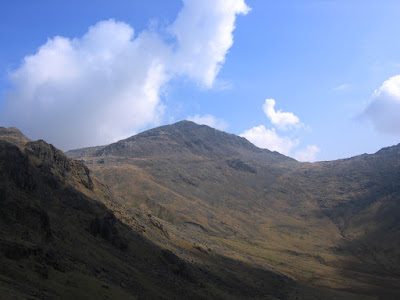This mountain satisfied me again despite the poor weather and when the clouds lifted I was rewarded with the great view again along the excellent ridge that was once again an utter delight to walk along. Coming down to Bealach Coire Làir I took the path into Coire Grannda and over Bealach Bàn into Coire Fionnaraich to the bothy that is in the valley. I had been going through a rough time on that holiday and needed a good walk to lift my spirits, which was precisely what Beinn Liath Mhor gave me. The prolonged traverse and stunning views wiped away all my disappointments of the previous few days as I looked forward in hope to a few days of good walking in the Coulin Forest. However, my ascent of Maol Chean-dearg the next day was marred by a stupidly steep ascent from Bealach na Lice that was relieved by a gloriously rocky descent to the saddle of Bealach a’ Choire Ghairbh that was reminiscent of the rocky ridge of Beinn Liath Mhor. I enjoyed more rock going up the Corbett of An Ruach-Stac from where I had a great view across the saddle towards the Munros of Coire Làir including Beinn Liath Mhor in the distance. The overcast weather failed to mar the walk in an area that is abundant in rock and with stunning views.
The final day of my few days of recuperation in the Coulin Forest in 2014 was spent returning to Coire Làir and it required tremendous effort for me to resist returning over Beinn Liath Mhor despite it being only two days since I was last there. Instead I turned right at Bealach Coire Làir and enjoyed a good path that took me all the way up to the top of Sgurr Ruadh where the views all around continued to be great. All the mountains in the Coulin Forest are great with the paths that link the valleys providing good routes to the mountains, but it will always be Beinn Liath Mhor that I turn to first. However, when I returned again in 2019 I resisted the temptation and kept to the path that passes through Coire Làir without topping either Munro. With hindsight, I wish I’d climbed Beinn Liath Mhor again, not only because it is a fabulous mountain, but also because by the time I reached the foot of Beinn Eighe, one of the Torridon giants, it was late afternoon and there was no time to do anything except put up my tent. I had been influenced by the fact that I’d already climbed Beinn Liath Mhor twice, but that should not have prevented me climbing a great mountain again.
My love affair with Beinn Liath Mhor started in 2009 with that walk out of Torridon that also introduced me to delights of the Coulin Forest. Excellent paths are the secret to this delightful area that provide easy access to dramatic looking mountains and will surely draw back to this area in the future. The best mountain walking is ridge walking and this is the secret to the delights of Beinn Liath Mhor, so when I do make a return visit to the Coulin Forest I’m sure I will then divert onto that awesome ridge that has been enthusing me for over ten years.










